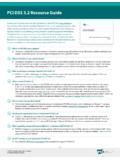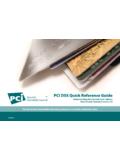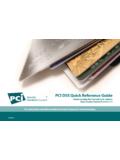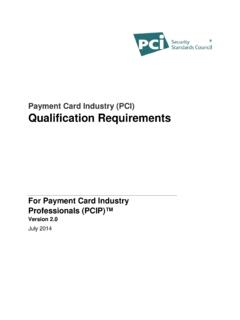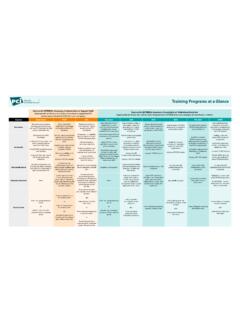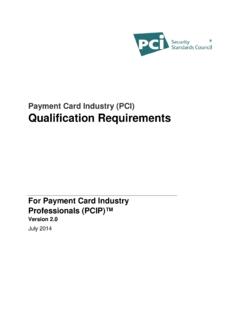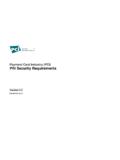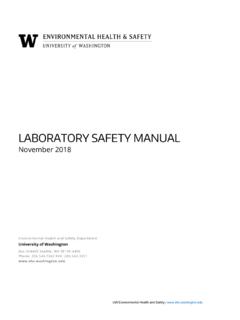Transcription of Payment Card Industry (PCI) Data Security Standard Self ...
1 Payment Card Industry (PCI). Data Security Standard Self-Assessment Questionnaire C-VT. and Attestation of Compliance Merchants with Web-Based Virtual Payment Terminals No Electronic Cardholder Data Storage For use with PCI DSS Version Revision January 2017. Document Changes PCI DSS SAQ. Date Description Version Revision To align content with new PCI DSS and to implement October 2008 minor changes noted since original To align content with new PCI DSS requirements and October 2010 testing procedures. To align content with PCI DSS requirements and February 2014 testing procedures and incorporate additional response options. Updated to align with PCI DSS For details of PCI. April 2015 DSS changes, see PCI DSS Summary of Changes from PCI DSS Version to July 2015 Updated version numbering to align with other SAQs. April 2016 Updated to align with PCI DSS For details of PCI.
2 DSS changes, see PCI DSS Summary of Changes from PCI DSS Version to Requirements added from PCI DSS Requirements 8, 9, and Appendix A2. January 2017 Updated Document Changes to clarify requirements added in the April 2016 update. Added footnote to Before You Begin section to clarify intent of permitted systems. Added Requirement to align with intent of Requirement Added Requirement to verify segmentation controls, if segmentation is used. PCI DSS SAQ C-VT, Rev. January 2017. 2006-2017 PCI Security standards Council, LLC. All Rights Reserved. Page ii Table of Contents Document Changes .. ii Before You Begin ..iii PCI DSS Self-Assessment Completion Steps .. iv Understanding the Self-Assessment Questionnaire .. iv Expected Testing .. v Completing the Self-Assessment Questionnaire .. v Guidance for Non-Applicability of Certain, Specific Requirements.
3 V Legal Exception .. v Section 1: Assessment Information .. 1. Section 2: Self-Assessment Questionnaire C-VT .. 4. Build and Maintain a Secure Network and Systems .. 4. Requirement 1: Install and maintain a firewall configuration to protect data .. 4. Requirement 2: Do not use vendor-supplied defaults for system passwords and other Security parameters .. 6. Protect Cardholder Data .. 9. Requirement 3: Protect stored cardholder 9. Requirement 4: Encrypt transmission of cardholder data across open, public networks .. 11. Maintain a Vulnerability Management Program .. 13. Requirement 5: Protect all systems against malware and regularly update anti-virus software or programs .. 13. Requirement 6: Develop and maintain secure systems and applications .. 15. Implement Strong Access Control Measures .. 16. Requirement 7: Restrict access to cardholder data by business need to know.
4 16. Requirement 8: Identify and authenticate access to system components .. 17. Requirement 9: Restrict physical access to cardholder data .. 19. Regularly Monitor and Test Networks .. 21. Requirement 11: Regularly test Security systems and processes .. 21. Maintain an Information Security Policy .. 22. Requirement 12: Maintain a policy that addresses information Security for all personnel .. 22. Appendix A: Additional PCI DSS Requirements .. 25. Appendix A1: Additional PCI DSS Requirements for Shared Hosting Providers .. 25. Appendix A2: Additional PCI DSS Requirements for Entities using SSL/early TLS .. 25. Appendix A3: Designated Entities Supplemental Validation (DESV).. 26. Appendix B: Compensating Controls Worksheet .. 27. Appendix C: Explanation of 28. Section 3: Validation and Attestation Details ..29. PCI DSS SAQ C-VT, Rev.
5 January 2017. 2006-2017 PCI Security standards Council, LLC. All Rights Reserved. Page ii Before You Begin SAQ C-VT has been developed to address requirements applicable to merchants who process cardholder data only via isolated virtual Payment terminals on a personal computer connected to the Internet. A virtual Payment terminal is web-browser-based access to an acquirer, processor, or third-party service provider website to authorize Payment card transactions, where the merchant manually enters Payment card data via a securely connected web browser. Unlike physical terminals, virtual Payment terminals do not read data directly from a Payment card. Because Payment card transactions are entered manually, virtual Payment terminals are typically used instead of physical terminals in merchant environments with low transaction volumes.
6 SAQ C-VT merchants process cardholder data only via a virtual Payment terminal and do not store cardholder data on any computer system. These virtual terminals are connected to the Internet to access a third party that hosts the virtual terminal Payment -processing function. This third party may be a processor, acquirer, or other third-party service provider who stores, processes, and/or transmits cardholder data to authorize and/or settle merchants' virtual terminal Payment transactions. This SAQ option is intended to apply only to merchants who manually enter a single transaction at a time via a keyboard into an Internet-based virtual terminal solution. SAQ C-VT merchants may be brick-and- mortar (card-present) or mail/telephone-order (card-not-present) merchants. SAQ C-VT merchants confirm that, for this Payment channel: Your company's only Payment processing is via a virtual Payment terminal accessed by an Internet- connected web browser.
7 Your company's virtual Payment terminal solution is provided and hosted by a PCI DSS validated third-party service provider;. Your company accesses the PCI DSS-compliant virtual Payment terminal solution via a computer that is isolated in a single location, and is not connected to other locations or systems within your environment (this can be achieved via a firewall or network segmentation to isolate the computer from other systems)1;. Your company's computer does not have software installed that causes cardholder data to be stored (for example, there is no software for batch processing or store-and-forward);. Your company's computer does not have any attached hardware devices that are used to capture or store cardholder data (for example, there are no card readers attached);. Your company does not otherwise receive or transmit cardholder data electronically through any channels (for example, via an internal network or the Internet).
8 Any cardholder data your company retains is on paper (for example, printed reports or receipts), and these documents are not received electronically; and Your company does not store cardholder data in electronic format. This SAQ is not applicable to e-commerce channels. 1 This criteria is not intended to prohibit more than one of the permitted system type (that is, a virtual Payment terminal accessed by an Internet-connected web browser) being on the same network zone, as long as the permitted systems are isolated from other types of systems ( by implementing network segmentation). Additionally, this criteria is not intended to prevent the defined system type from being able to transmit transaction information to a third party for processing, such as an acquirer or Payment processor, over a network. PCI DSS SAQ C-VT, Rev.
9 January 2017. 2006-2017 PCI Security standards Council, LLC. All Rights Reserved. Page iii This shortened version of the SAQ includes questions that apply to a specific type of small merchant environment, as defined in the above eligibility criteria. If there are PCI DSS requirements applicable to your environment that are not covered in this SAQ, it may be an indication that this SAQ is not suitable for your environment. Additionally, you must still comply with all applicable PCI DSS requirements in order to be PCI DSS compliant. PCI DSS Self-Assessment Completion Steps 1. Identify the applicable SAQ for your environment refer to the Self-Assessment Questionnaire Instructions and Guidelines document on PCI SSC website for information. 2. Confirm that your environment is properly scoped and meets the eligibility criteria for the SAQ you are using (as defined in Part 2g of the Attestation of Compliance).
10 3. Assess your environment for compliance with applicable PCI DSS requirements. 4. Complete all sections of this document: Section 1 (Parts 1 & 2 of the AOC) Assessment Information and Executive Summary. Section 2 PCI DSS Self-Assessment Questionnaire (SAQ C-VT). Section 3 (Parts 3 & 4 of the AOC) Validation and Attestation Details and Action Plan for Non-Compliant Requirements (if applicable). 5. Submit the SAQ and Attestation of Compliance (AOC), along with any other requested documentation such as ASV scan reports to your acquirer, Payment brand or other requester. Understanding the Self-Assessment Questionnaire The questions contained in the PCI DSS Question column in this self-assessment questionnaire are based on the requirements in the PCI DSS. Additional resources that provide guidance on PCI DSS requirements and how to complete the self- assessment questionnaire have been provided to assist with the assessment process.
